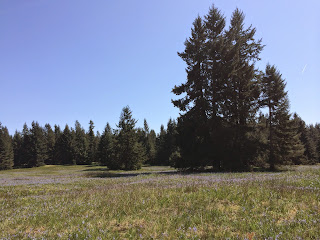Weekend field trip
Saturday, May 2
Mostly clear
We drove down to the Nisqually Delta for the second field trip. The Nisqually Delta has special landscape because of the salt water marsh one the one side, and fresh water marsh on the other side. The U shaped lake is the evidence of this area has been cut down by the river. The Nisqually River flows through the wildlife refuge, and this is the place where one could observe many different species of birds and animals. We saw barn swallow, tree swallow, Redwing Blackbird, frogs, Northern Shoveler duck, Canadian geese, many sparrows, and even a coyote.
The brownish mud floods on the salt water marsh side is the evidence of iron deposits. I can clearly see the difference in vegetation on two sides divided by the trail. More plants and animals habitat on the fresh water marsh side, whereas the muddy bare ground on the salt water marsh side. I can also smell the sea-like salty water in the air. I did not have the chance to look closely at the mud, but I learned from the signs that there are thousands of tiny holes, tracks, and droppings on the mud, which are the evidence of bustling activity. The animals that resident in the estuary must cope with a constantly changing environment because of the tides. Here are the two landscape pictures I took and you can see how different are they only at a close distance.


There are many tree swallows, cliff swallows fly around the two barns. These swallows build their nests under the barn's roof. The tree swallows have bright blue back and white underparts. The cliff swallows have brownish back and white underparts as well.
We then drove down to the South Sound Prairies, where is good place for observing wildflowers and butterflies. I saw Western Buttercup, Camas, and possibly Woodland Strawberry.
The picture below is a Common Camas. It has bright blue flowers with flat spreading petals. The Woodland strawberry has white 5 rounded petals, red hairy stalks and serrated leaves.
Our last stop was the Mima Mounds, formed roughly after ice age glaciers began receding. I found this place was my favorite one for this field trip because the interesting mounded landscapes. I have never seen this topography before. It is hard to believe that these circular and about same size mounds are formed by the nature. I love hearing all those mysterious theories that explain the Mima Mounds.



















.JPG)

.JPG)
.JPG)
.JPG)
.JPG)
.JPG)
.JPG)
.JPG)